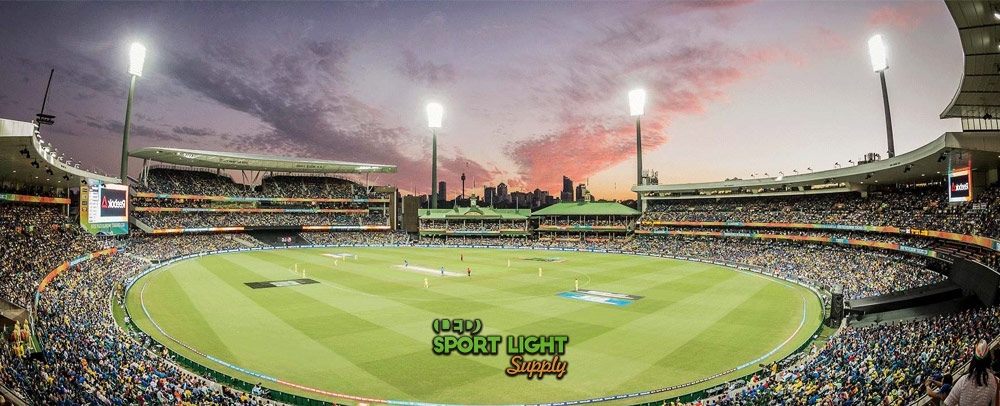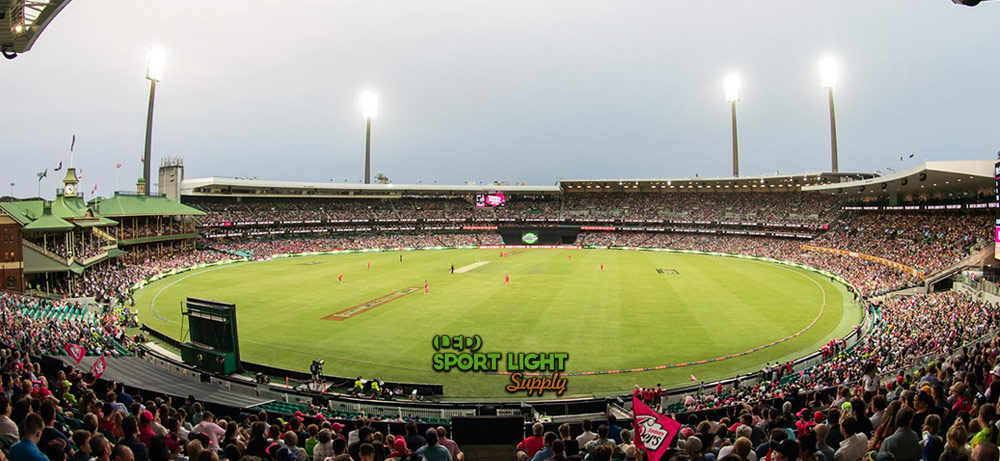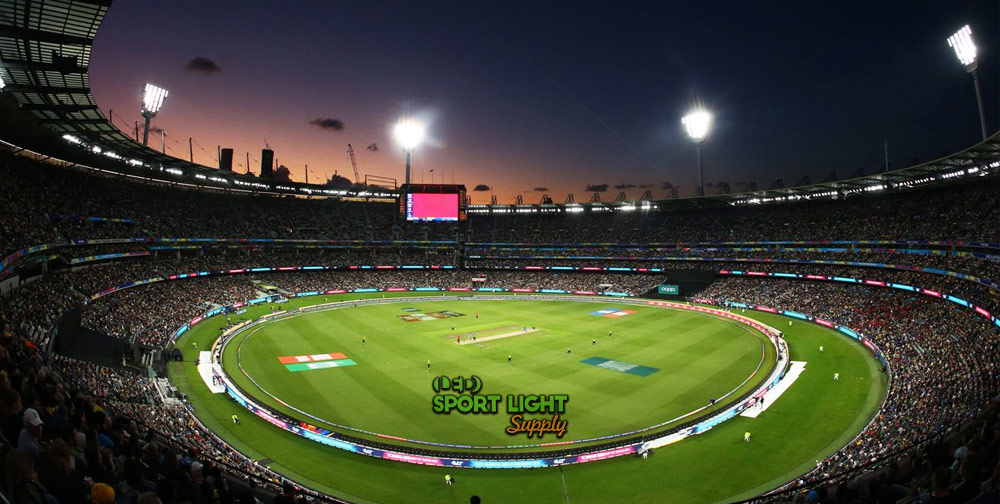How Tall Are Cricket Field Lights? When planning the construction of a new cricket stadium, one key consideration is the height of the light poles used to illuminate the field. Achieving optimal lighting is crucial for both player performance and spectator experience, and the height of the poles plays a significant role in this. Poles that are either too tall or too short can lead to uneven lighting and visibility issues. This article explores the typical height of light poles for cricket fields and discusses the various factors that influence their optimal placement.
Table of Contents
ToggleCommon Cricket Stadium Light Pole Heights

The height of light poles in cricket stadiums typically ranges from 14 to 50 meters (46 to 164 feet). This range varies based on the level of competition and the size of the field. For more professional and larger cricket venues, taller light poles are generally used to ensure adequate illumination across the expansive playing area.
| Class | Applications of cricket field | Average cricket field light pole height |
| III | Recreational | 14 to 20 meters (46 to 66ft) |
| II / III | Training, high school or college practice field | 22 to 30 meters (72 to 98ft) |
| I / II | Local or regional competitions | 25 to 33 meters (82 to 108 ft) |
| I | National or international tournament | 30 to 50 meters (98 to 164ft) |
Recreational Cricket Fields
For recreational cricket fields, light poles typically range from 14 to 20 meters in height. This level of illumination is generally sufficient for amateur play, where the lighting requirements are less stringent compared to professional levels. In some cases, especially for smaller or less intensively used fields, shorter poles ranging from 6 to 8 meters might be used. The specific choice depends on the field’s design and layout, as well as the expected level of use.
Training / High School / College Cricket Practice Fields
In high school and college cricket practice fields, light poles are usually set between 22 and 30 meters high. The increased height is necessary to accommodate the larger field sizes and the higher lighting standards required for effective training and practice sessions. Brighter lights are crucial for clear visibility of the cricket ball and players’ movements. Moreover, these fields are often used for local competitions, making taller poles beneficial for providing adequate illumination for both players and spectators.
Local or Regional Competitions
For cricket fields used in local or regional competitions, the height of the light poles typically ranges from 25 to 33 meters. This height ensures that the lighting is bright and uniform enough to cater to the needs of a larger audience. The increased pole height helps in achieving consistent lighting across the entire field, which is important for both player performance and spectator experience during competitive matches.

International / National Tournament Cricket Stadiums
In stadiums that host international or national cricket tournaments, light poles generally reach heights between 30 and 50 meters. Such heights are required to meet the stringent requirements for both horizontal and vertical illuminance. Taller poles are essential for achieving high levels of vertical illuminance, which is crucial for clear visibility during high-definition TV broadcasts. Additionally, the lighting must be ultra-bright, flicker-free, and glare-free to ensure the highest quality viewing experience, particularly for 4K or 8K television coverage.
Importance of Getting the Right Light Pole Height for Cricket Fields
Proper light pole height is crucial in cricket fields to ensure optimal lighting quality for athletes, referees, and cricket fans. The correct height can significantly impact the effectiveness and efficiency of the lighting system, influencing everything from energy consumption to visual comfort.
Minimizing Cricket Field Lighting Wattage
Choosing the appropriate height for light poles can help reduce the overall wattage required for lighting a cricket field. Shorter poles can decrease power consumption, avoiding the need for excessively high wattages that may not be necessary for every type of cricket field. For example, installing 50-meter-tall poles on a recreational field is unnecessary and could lead to wasted energy due to light beam attenuation.
Typically, LED cricket lights come in wattages such as 400W, 1000W, 1500W, and 2000W. By selecting the right pole height, we can use these various wattages more efficiently, ensuring optimal brightness and uniformity without over-illuminating the field.
Improving Lighting Uniformity
The height of light poles also affects the uniformity of lighting across the cricket ground. High poles can enhance lighting uniformity, similar to the even distribution of sunlight. Uniform lighting reduces the presence of shadows and dark spots, which is crucial for players who need consistent visibility to track the cricket ball and see batting movements clearly.
High lighting uniformity ensures that there are fewer abrupt changes in brightness, which can otherwise strain players’ eyes and affect their performance. By using taller poles, the uniformity of stadium lights can improve by 0.1 to 0.3, creating a more consistent playing environment.
Minimizing Glare
Glare from high-power floodlights can cause eye discomfort and reduce visual performance. Elevated light poles help mitigate glare by positioning the lights at a height where players are less likely to accidentally look directly at the lights. This positioning helps maintain visual comfort and reduces distractions during gameplay.
Saving on Light Pole Costs and Installation
The cost of cricket field floodlights and light poles can be substantial. By selecting the appropriate pole height, you can optimize the lighting design to use fewer poles and watts while still maintaining high-quality illumination. This approach not only improves lighting efficiency but also helps in managing costs associated with both equipment and installation.

Factors Affecting Cricket Stadium Light Pole Height
The height of light poles in cricket stadiums is determined by various factors, each contributing to the overall effectiveness of the lighting system. While the height range for Class I stadiums is typically 30 to 50 meters (98 to 164 feet) and for Class III stadiums is 14 to 20 meters (46 to 66 feet), these variations are influenced by several key considerations.
Size of the Cricket Ground
The dimensions of the cricket ground significantly impact the required height of the light poles. Larger stadiums necessitate taller poles to ensure that light beams cover a greater distance and provide uniform illumination across the entire field. In contrast, smaller recreational or training grounds may require shorter poles, as the lighting coverage area is less extensive.
Level of Competition
The height of light poles also varies according to the level of competition held at the stadium. Recreational fields, which have less stringent lighting requirements, generally use shorter poles. Conversely, professional and international venues, such as those hosting ICC or T20 World Cup matches, require taller poles to meet higher standards of brightness, uniformity, and anti-glare performance. Taller poles facilitate achieving the bright and consistent lighting necessary for high-level competitions.
Beam Angle of LED Cricket Flood Lights
Different types of floodlights and spotlights are used to illuminate various areas of the cricket field, depending on their beam angles. Floodlights, with wider beam angles (60 or 90 degrees), are typically used for the outfield, while spotlights, with narrower beam angles (15 or 25 degrees), focus on the cricket pitch. The height of the light poles must be adjusted based on these beam angles to ensure effective coverage and minimize shadowing.
The Cricket Ground Construction Site
The construction site of the cricket ground can impose limitations on the maximum allowable height for light poles. Factors such as soil conditions and foundation stability may restrict the height of the poles. It is essential to consult with a land surveyor before construction to assess whether the site can support poles of 30 to 50 meters. If higher poles are not feasible, customized lighting designs can still achieve high-quality illumination.
Neighboring Area – Light Pollution Control
When a cricket field is situated near residential areas, controlling light pollution becomes crucial. Excessively tall light poles can result in significant light spill and affect nearby residents’ quality of life. To mitigate light pollution, several strategies can be employed, including lowering the height of the poles, using smaller beam angles for more concentrated light, and adding barn doors to floodlights to minimize light spill.
Preferences of Cricket Stadium Owners
Stadium owners may have specific preferences regarding light pole height to manage costs effectively. Shorter and fewer poles can reduce both lighting and installation expenses. However, this approach may present challenges in achieving the desired level of lighting uniformity, which can impact the overall quality of the playing environment. Balancing cost considerations with lighting performance is a key aspect of stadium design.
Pros and Cons of Higher Cricket Ground Light Poles
Pros
Better Lighting Uniformity
Higher light poles, generally those over 20 meters, facilitate superior lighting uniformity, typically ranging from 0.7 to 0.8. This is because taller poles allow light beams to spread more evenly across the entire cricket ground, including all corners and the central pitch. If the poles are too short, the light coverage may be insufficient, leading to darker areas on the field, particularly in the central cricket pitch.
Reduced Glare
An additional advantage of taller poles is the reduction of glare. By mounting floodlights at a greater height, the likelihood of players accidentally staring directly at the blinding lights is minimized. Glare can significantly affect athletic performance, as the intense brightness can cause discomfort and impair vision.
Cons
Increased Light Pollution
One of the main drawbacks of taller light poles is the potential for increased light pollution. When a cricket ground is near residential areas, high poles can cause significant light leakage, leading to complaints from nearby residents about light disturbances. This can affect the sleep quality of local residents and result in increased noise and light complaints.
Higher Wattage Requirements
Tall poles require more lumens and watts to adequately illuminate the cricket field due to the longer distance the light beams must travel. This increased distance leads to greater light loss, which in turn raises both the lighting costs and the electricity bills. Higher wattage can be costly and less energy-efficient.
Pros and Cons of Shorter Cricket Ground Light Poles
Pros
Lower Installation Cost and Time
Shorter light poles can reduce both installation costs and time. The installation of lower poles generally requires less specialized equipment, such as industrial lifts and cranes. Additionally, the safety risks associated with working at great heights are minimized, potentially lowering insurance costs for the workers.
Reduced Wattage Requirements
With shorter poles, the wattage and number of lighting fixtures needed can be decreased due to reduced light loss over shorter distances. For instance, shortening the pole height by 3 to 5 meters can result in up to a 5% reduction in wattage. This method is particularly suitable for smaller cricket grounds where extensive illumination is not required.
Cons
Poor Lighting Uniformity
Shorter light poles often result in poor lighting uniformity. The limited height makes it challenging to achieve consistent illumination across the entire field, especially the long distance of the cricket pitch. This can lead to darker areas, negatively impacting the visibility and experience for players and spectators. While using a narrow beam angle might help illuminate the pitch, it can also increase glare.
Increased Temperature
When high-power floodlights are mounted closer to the ground, the temperature around the field can rise, which might be uncomfortable, especially during summer evenings. While this can provide warmth in winter, it can cause excessive sweating and discomfort for players. To mitigate this, using energy-efficient LED lights can be beneficial, as they produce less heat compared to halogen, metal halide, or high-pressure sodium lights.
Conclusion
Taller poles provide better lighting uniformity and reduced glare, which enhances player visibility and game performance. However, they come with higher installation costs and increased energy consumption, and they can lead to greater light pollution. Shorter poles, on the other hand, lower installation costs and reduce energy usage, but may result in uneven lighting and increased glare. They also tend to increase the temperature around the field, which can be uncomfortable in warmer conditions.
